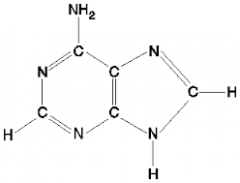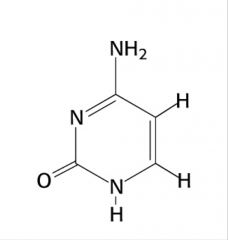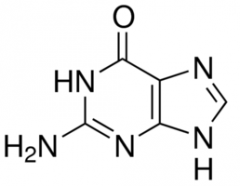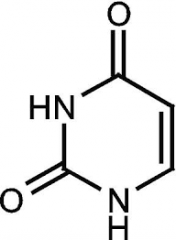![]()
![]()
![]()
Use LEFT and RIGHT arrow keys to navigate between flashcards;
Use UP and DOWN arrow keys to flip the card;
H to show hint;
A reads text to speech;
94 Cards in this Set
- Front
- Back
|
What crucial criteria must genetic material have? |
-had to contain information that controls the production of enzymes and proteins -had to be able replicate themselves to maintain continuity through generations -had to have the ability to allow for occasional mutations for introducing variations with a species |
|
|
How many amino acids are proteins made up of? How many nucleotides are nucleic acids made up of? |
-20 -4 |
|
|
What did Fredrick Griffith do? Describe his experiment and what he concluded? |
- He used two strains, s-train (pathogenic) and r-strain (non-pathogenic), of Streptococcus Pneumonaie to determine the material of heredity -He discovered that mice died after being injected with a mixture of a heat-killed, no longer pathogenic s-strain, and a living r-strain -Griffith concluded that the heat-killed s-strain passed on deadly properties to the r-strain -Called the phenomenon the transforming principle |
|
|
What did Avery, Macloed, and McCarty discover? Describe their experiment. |
-They discovered that DNA was the hereditary material -They prepare identical extracts of the heat-killed s-strain subjected each to one of three enzymes (one that killed proteins, one that killed RNA and one that killed DNA) -The only extract that didn't allow the transformation of the r-strain was the one that destroyed DNA |
|
|
What did Hershey and Chase discover? Describe their experiment? |
-They ruled out protein as the material of hereditary and that DNA in fact was -Using T2 Bacteriophages, they separately labelled the protein of the virus with S35, and the DNA with P32, let the virus infect a bacteria -After agitation, radioactivity was found in the bacteria pellet when DNA was radioactively labbelled, which could only happen if DNA entered the bacteria |
|
|
What did Fredrich Meiescher discover? |
After isolating the nuclei of white blood cells, he found a weakly acidic substance containing nitrogen and phosphorus. He called it nuclein, because it was found in the nuclei, but he had really found DNA. |
|
|
What did Phoebus Levene discover? |
After isolating two types of nucleic acid, RNA and DNA, he proposed that the two were composed of individual units called nucleotides. He discovered that nucleotides were composed of a nitrogenous base, a sugar, and a phosphate group. |
|
|
Nucleotides are identified by referring to their bases. Name the nucleotides in DNA Name the nucelotides in RNA |
-Adenine, Thymine, Guanine, Cytosine -Adenine, Uracil, Guanine, Cytosine |
|

What nucleotide is this? Is it Purine or pyrimidines? |
Adenine -purines |
|

What nucleotide is this? Is it Purine or pyrimidines?
|
Thymine -Pyrimidines |
|

What nucleotide is this? Is it Purine or pyrimidines?
|
Cytosine -pyrimidines |
|

What nucleotide is this? Is it Purine or pyrimidines?
|
Guanine -purines |
|

What nucleotide is this? Is it Purine or pyrimidines?
|
Uracil -pyrimidines |
|
|
What did Erwin Chargaff discover? |
-There is a variation between nucleotide compositions between species -Regardless of species, DNA maintains certain nucleotide proportions, that the amount of A = T, and the amount of G=C -Chargaff's rule - DNA composition is the same between A and T, and C and G |
|
|
What did Linus Pauling Discover? |
That many proteins have a helical shape based on known distanced and bond angles between atoms in a molecule. |
|
|
What did Rosalind Franklin and Maurice Wilkins discover? |
They used x-ray diffraction images to analyze DNA samples. They discovered from a high-resolution photograph of DNA, that DNA has a helical structure with nitrogen bases on the insides and the sugar-phosphate backbone on the outside. |
|
|
In early 1953, Watson and Crick built the 3-Dimensional model of DNA. What were its features? |
-A twisted ladder (double helix) with sugar-phosphate molecules making up the handrails of the ladder, and the bases making the rungs by protruding inward -The distance between the sugar-phosphate backbones remains constant over the length of the molecule, with A sitting across from T, and G from C -There are different sequences of base pairs that account for the differences among species |
|
|
What is complementary base-pairing? |
The interactions of bases of nucleotides on opposite strands through the formation of hydrogen bonds in DNA |
|
|
How is DNA Antiparrallel? |
The directionality of the two strands in a DNA molecules; the strands run in opposite directions with each end of DNA containing the 3' end of one strand and the 5' end of the other strand |
|
|
List the Structural Features of DNA |
-Double helix of 2 polynucleotide strands that twist around each other -alternating backbone of sugars and phosphate groups on each strand -Constant distance btwn sugars and phosphates -the bases of each nucleotide are attached to the sugars -The strands are complementary due to complementary base pairing -Complementary base pairs are linked with hydrogen bonds -each strand has a 5' end and a 3' end -strands are antiparallel -sequence is written in 5' to 3' direction |
|
|
What is DNA's primary structure? What is DNA's secondary structure? What must be considered to relate them to DNA function? |
-how the nucleotides are linked -how two strands for a double helix -How DNA is organized in the cell and How its genome is arranged |
|
|
What is the genome of a cell? |
The complete genetic makeup of an organism/ total DNA sequence |
|
|
What is a gene? |
The basic functional unit of heredity that determines, in a whole or part, a genetic trait; A specific sequence of DNA that encodes for proteins and RNA molecules, and mainly composed of non-coding sequences that regulated these molecules |
|
|
What form is the DNA of prokaryotes? Where are they packed? |
-circular, double-stranded -In the Nucleoid |
|
|
What is DNA Supercoiling? |
The formation of additional coils in the sturcture of DNA due to twisting forces in the molecule controlled by the enzymes Topoiosermerase I ans II |
|
|
What are plasmids? |
Small, circular, or linear DNA molecules some prokaryotes have that often carry non-essential genes. |
|
|
Prokaryotes are haploid, what does that mean? What do most hapoloid genomes contain? |
-They only have one set of chromosomes, and carry only one copy of each gene. -Haploid;s genomes carry very little non-essential DNA, mostly regulatory sequences |
|
|
What are Regulatory Sequences? |
Sections of DNA sequences that regulate the activity of the gene, determining when certain genes and associated cell functions are activated. |
|
|
What form does Eukaryotic DNA have? |
Double-stranded, linear molecule that is tightly compacted in the nucleus of eukaryotic cells. |
|
|
Why does eukaryotic DNA have to go through much greater compacting than prokaryotic DNA? |
The amount of DNA is much greater. |
|
|
How is the compacting of DNA in the nucleus of eukaryotic cells achieved? |
Through different levels of organizations involving interactions between linear sections of DNA and several proteins to form a series of defined structures. |
|
|
What are Histones? What are Nucleosomes? |
-A member of a family of proteins that associate with DNA in eukaryotic cells to help compact DNA -The condensed structure formed when double-stranded DNA wraps around an octamer of histone proteins |
|
|
Most eukaryotoes are diploid, what does that mean? |
They contain two copies of each gene. |
|
|
The size and number if genes in eukaryotic genomes vary. Is there a correlation between an organism's complexity and genome size? |
No |
|
|
What is DNA replication? |
The process of producing two identical DNA molecules from an original, parent DNA molecule |
|
|
When does DNA replication take place in the cell cycle? |
The S phase of interphase |
|
|
What did Watson and Crick propose about DNA replication? |
That the two strands of DNA must unwind and, separate to serve as a template for the formation of a new companion chain. |
|
|
What are the three proposed models of DNA replication? |
-Conservative -Semi-Conservative -Dispersive Model |
|
|
Explain the Conservative Model of DNA replication. |
Replication involves the formation of two daughter strands from parent templates with the two new strands joining into a double helix and the original parent strands reforming the parent molecule. |
|
|
Explain the Semi-Conservative Model of DNA replication |
Each new molecule of DNA would contain one strand of the original complementary DNA molecule and one new strand. |
|
|
Explain the Dispersive Model of DNA replication. |
The parental DNA molecules are broken into fragments and that both strands of DNA in each daughter molecule were made up of an assortment of the parental and new DNA. |
|
|
Who discovered the real model for DNA replication? |
Matthew Meselson and Franklin Stahl |
|
|
What did Meselson and Stahl reason about the proposed models of DNA replication? |
That they could be tested if they could distinguish between the original parent strands and the daughter strands. |
|
|
Describe Meselson and Stahl's experiment for discovering the model of DNA replication and their results. |
-They used two different types of nitrogen, N-14 (light) and N-15 (heavy) to incorporate into the replication process which would help them separate the parent and daughter strands according to density after centrifugation -They grew DNA in an N-15 medium and transferred them into N-14 mediums -DNA grown in the N-15 medium has a uniform heavy density, containing only N-15 -the DNA was transferred to an N-14 medium an after one round of replication, the DNA was positioned midway between the densities of N-14 and N-15 (composed of both) -After another round of replication in an N-14 medium, the DNA split into two distinct bands, one containing only N-14, and one containing N-14 and N-15 -This concluded that the Semi-Conservative Model was the Model of DNA replication |
|
|
What is Semi-Conservative Replication? |
The mechanisms of DNA replication in which each newly synthesized DNA molecule is composed of one strand of the original DNA molecule and one new one |
|
|
Name the three basic phases of DNA replication |
-Initiation -Elongation -Termination |
|
|
Describe Initiation in DNA replication |
Replication begins at a specific nucleotide sequence called the origin of replication. Initiator proteins bind to the origin of replication on the DNA and Helicase unwinds the molecule by cleaving the hydrogen bonds between base pairs. Single-stranded binding proteins stabilize the newly unwound strands and Topoisomerase II or gyrase help relieve the strain on the double helix from the unwinding process. The unwinding process results in an unwound area called the replication bubble with replication forks at each end. |
|
|
Describe the Elongation phase of DNA replication |
Two new strands of DNA are assembled using the parent DNA as a template. The enzyme DNA polymerase III adds nucleotides to the 3' end of a growing polynucleotide strand, complementary to the parent strand. -In the synthesis of the leading strand, DNA polymerase III adds nucleotides in a continuous fashion because the leading strand is synthesis in the 5' to 3' direction and has a free 3' hydroxyl end. -The synthesis of the lagging strand is discontinuous because it is synthesized in the 3' to 5' direction, therefore not have a free 3' end. Primase synthesizes RNA primers to start replication of the lagging strand. DNA polymerase can then elongate the primers by synthesizing Okazaki fragments. DNA polymerase I removes the primers, replacing them with the correct nucleotides, and DNA ligase joins the Okazaki fragments together |
|
|
Describe the Termination phase of DNA replication |
The replication process is completed and the DNA molecules separate. The newly formed strands wind with the complementary parent strand and form a helical structure. The replication machine is dismantled. |
|
|
What is Mispairing? |
incorrect pairing of nucleotide bases from flexiility in the DNA structure |
|
|
What is Strand Slippage? |
An error in DNA replication that can cause the addition or omission of nucleotides in newly synthesized strands |
|
|
List the similarities of DNA replication in prokaryotes and eukaryotes |
-origins of replications -elongation in the 5' to 3' direction -continuous synthesis of leading strand -discontinuous synthesis of lagging strand] -use of primase for synthesis of Okazaki fragments -use of DNA polymerase enzymes |
|
|
List the difference of DNA replication in prokaryotes and eukaryotes |
-Prokaryotes have faster rate of replication -DNA polymerase enzymes are different in number and structure -DNA in prokaryotes have one origin of replication -DNA in eukaryotes have many -linear chromosomes contain telomeres, highly repetitive sequence on the ends, to ensure no genetic material is lost |
|
|
What is Molecular Biology? |
The study of the structure and functions of nucleic acids and proteins |
|
|
How can the techniques of isolated and manipulating DNA help Molecular Biologists? |
Helps them investigate the properties of nucleic acids and proteins |
|
|
What is Recombinant DNA? |
A molecule of DNA composed of Genetic Material |
|
|
What made the ability to prepare recombinant DNA possible? |
The isolation and discovery of restriction enzymes |
|
|
In prokaryotes, what do restriction enzymes do? |
They defend prokaryotes against infection by foreign viruses by restricting the replication of infecting viruses by cleaving the viral DNA in the interiour of the molecule |
|
|
What are Restriction Endonucleases? |
Enzymes that cleave the interiour of double-stranded DNA in a sequence specific manner |
|
|
How do Restriction Endonucleases cut DNA? |
They recognize a short sequence of nucleotides, called the target sequence, and then cut the strand at a particular site known as the restriction site. Each restriction endonucleases recognize different target sequences |
|
|
What are the two important characteristics of restriction endonucleases that make them useful to researches? |
-Sequence Specificity - the cuts made by restriction endonucleases are specific and predictable because it will cut a particular strand in the same way each time -Staggered Cuts - Restriction endonucleases produce staggered cuts which leave unpaired nucleotides called sticky ends. The sticky ends can be used to reform base pairing with complementary sticky ends |
|
|
How is recombinant DNA made? |
Having two fragments from different sources cut with the same enzyme to produce complementary single-stranded sticky ends. Complementary base-pairing between these ends will bring the molecule together. |
|
|
Describe the steps in making Recombinant DNA |
-A restriction endonuclease is selected -Each piece of DNA is cut by the same restriction endonuclease to produce restriction fragments -DNA ligases joins the strands by forming covalent bonds btwn the two different fragments to produce a double-stranded recombinant DNA |
|
|
What is gene cloning? |
the process of manipulating DNA through many steps to produce identical copies of a gene or another segment of DNA found in foreign cells |
|
|
What is often used as host systems for gene cloning? What is often used as a vector? |
-Bacteria -Plasmid, a circular piece of DNA |
|
|
Describe the steps of Gene Cloning |
- A recombinant DNA molecule composed of the gene of interest is carried in a vector - DNA is taken up by the bacteria through transformation - The bacteria cells are applied to a Petri dish with growth media -Recombinant DNA is identified in bacterial colonies with selective markers -Colonies with recombiant DNA are transferred to liquid culture to grow in larger colonies -The recombinant DNA molecules are isolated and purified -The recombinant DNA is analyze to confirm that the correct DNA molecule was made. |
|
|
What is DNA amplification? Give two examples of DNA amplification. |
The process of producing large quantities of DNA from a sample - Polymerase Chain Reactions - Gene cloning |
|
|
What is Polymerase Chain Reactions (PCR)? |
An automated method for amplifying specific regions of DNA from extremely small quantities; a highly specific and rapid amplification method. |
|
|
Summarize the steps in Polymerase Chain Reactions |
1. Denaturation - A sample DNA is chosen and heated to a high temperature (95) to denaturize the double-stranded DNA 2. Primer Annealing - the DNA sample is cooled (55) in the presence of primers to complementary base pair with the 3' end of each single strand 3. DNA synthesis - the DNA sample is cooled (72) with a DNA polymerase to extend the primers to create complementary strands 4. The DNA is taken through several cycles to produce more copies of the DNA fragments |
|
|
What is the standard method for analyzing DNA fragments? |
Gel Electrophoresis |
|
|
What is Gel Electrophoresis? |
A tool used to separate molecules using an electric field according to their mass and charge as they pass through a gel; to separate fragments of DNA |
|
|
Summarize the steps of Gel Electrophoresis? |
1. DNA fragments of different sizes are added to the gel and treated with chemicals to make them visible 2. The gel is put into a buffer solution, a power source is turned on and an electrical current runs between the cathode and anode at opposite ends 3. Negatively charged DNA fragments are repelled by the negative end and pulled by the positive end. 4. The smaller the DNA fragments, the more easily it will move through the gel and the further it will go. DNA fragments are then separated by size. 5. The gel is removed from the buffer and exposed to UV light to be observed. |
|
|
What is DNA Fingerprinting? Name two ways this can be done. |
A technology used to identify individuals by analyzing the DNA sequence of certain regions of their genomes. -Restriction Fragment Polymorphism (RFLP) -Short Tandem Repeat |
|
|
Explain Restriction Fragment Polymorphism |
-chromosomal DNA is treated with restriction endonucleases -DNA restriction fragments are separated and analyzed in gel electrophoresis |
|
|
How can DNA fingerprinting identify a person? |
Because the DNA of an individual is unqique |
|
|
What is Short Tandem Repeat (STR) profiling? |
A technology used to identify individuals based on repeating short sequences of DNA in the genome that vary in length between individuals |
|
|
What is DNA sequencing? |
A method for determining the nucleotide sequence, base by base, of a fragment of DNA |
|
|
Who developped Dideoxy Sequencing? |
Fredrick Sanger |
|
|
What is Dideoxy Sequencing? |
A method for determining the sequence of DNA fragment using dideoxynucleotides, which cause the termination of DNA synthesis during the procedure |
|
|
Why does the incorporation of dideoxynucleotides stop the synthesis of DNA? |
Because of the lack of hydroxyl group on the 3' and 2' carbon of the sugar |
|
|
Summarize the steps in Dideoxy Sequencing |
1. DNA sample to be sequenced is denatured and have a primer annealed to the 3' end. 2. Four separate reactions are prepared each containing the single-stranded DNA with a primer, DNA Polymerase, and one of four dideoxynucleotides 3. DNA synthesis proceeds and DNA fragments of different sizes are produced after the incorporation of dideoxynucleotides 4. Each reaction is separated in gel electrophoresis 5. The gel is read and helps determine the sequence of the synthesized strand. |
|
|
What is the Human Genome Project? |
A project that sequenced the human genome and identified all the genes within it |
|
|
What is Site-directed Mutagenisis and what does it allow scientists to do? |
A method f specifically altering the nucleotide sequence of a region of DNA which helps scientists study the structure and functions of genes and proteins. |
|
|
What is Gene therapy? |
A method for treating diseases and genetic disorders by introducing the correct form of the disease-related gene into an individual's genome |
|
|
What is Genetic Engineering? |
Alteration of the genetic material of an organism is a specific manner |
|
|
What is a transgenic organism? |
An organisms that is produced from the introduction of foreign DNA into its genome, providing it with a new phenotype |
|
|
What is a genetically modified organism? |
An organism whose genetic material has been modified, often through the insertion of a foreign gene into its genome |
|
|
What is biotechnology? |
The use of an organism or a product of an organism for the benefit of humans |
|
|
What is an expression Vector? |
the plasmid vector that is transformed into a host cell for the purpose of producing a foreign protein |
|
|
What is Bioremediation? |
the use of micro-organisms or living cells for environmental clean up. |
|
|
What are two ways in producing transgenic plants? |
-The Biolistic Method -The Ti Plasmid method |
|
|
Explain the Biolistic method? What is wrong with it? |
A method that involves bombarding plant cells with particles coated with DNA at a very high speed which allows the DNA to become integrated into the plant's genome -does not have control of the insertion site or how many copies of the gene is introduced |
|
|
Explain the Ti Plasmid Method. |
A method that uses a tumour-inducing plasmid from Argobacterium Tumefaciens as a vector for the insertion of a foreign gene into a plant's genome |
|
|
What is Gene Pharming? |
The process of using transgenic livestock to produce therapeutic proteins and pharmaceuticals |

